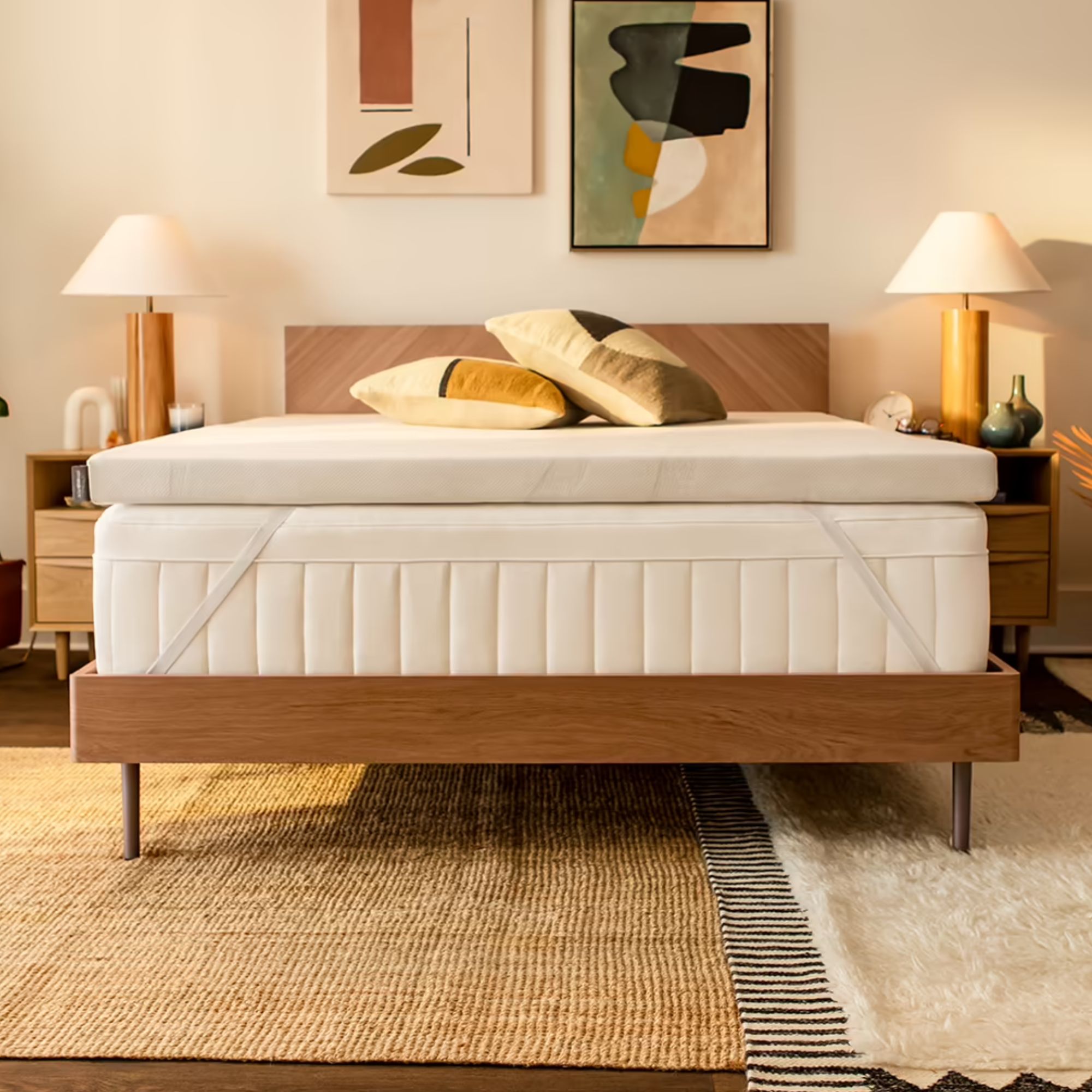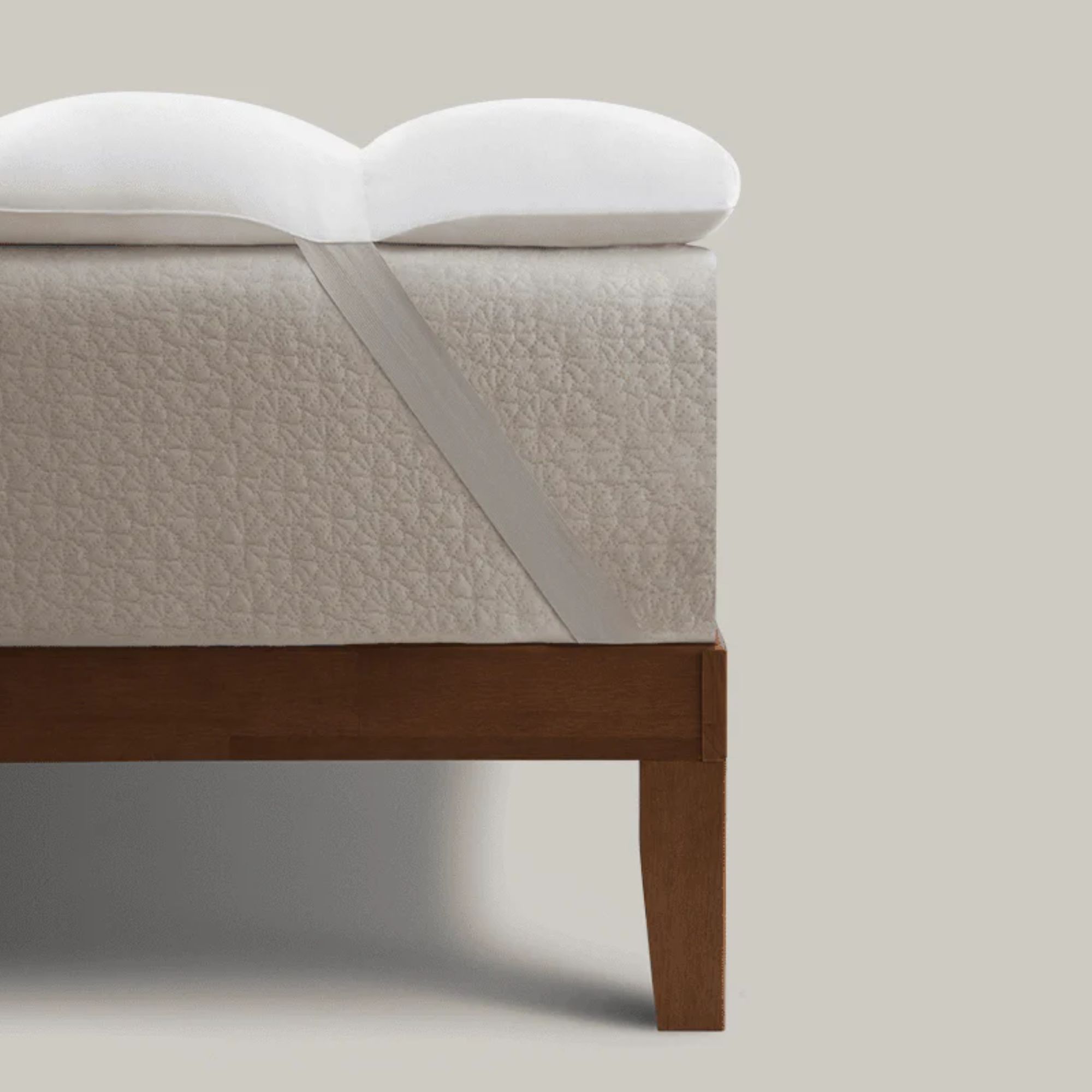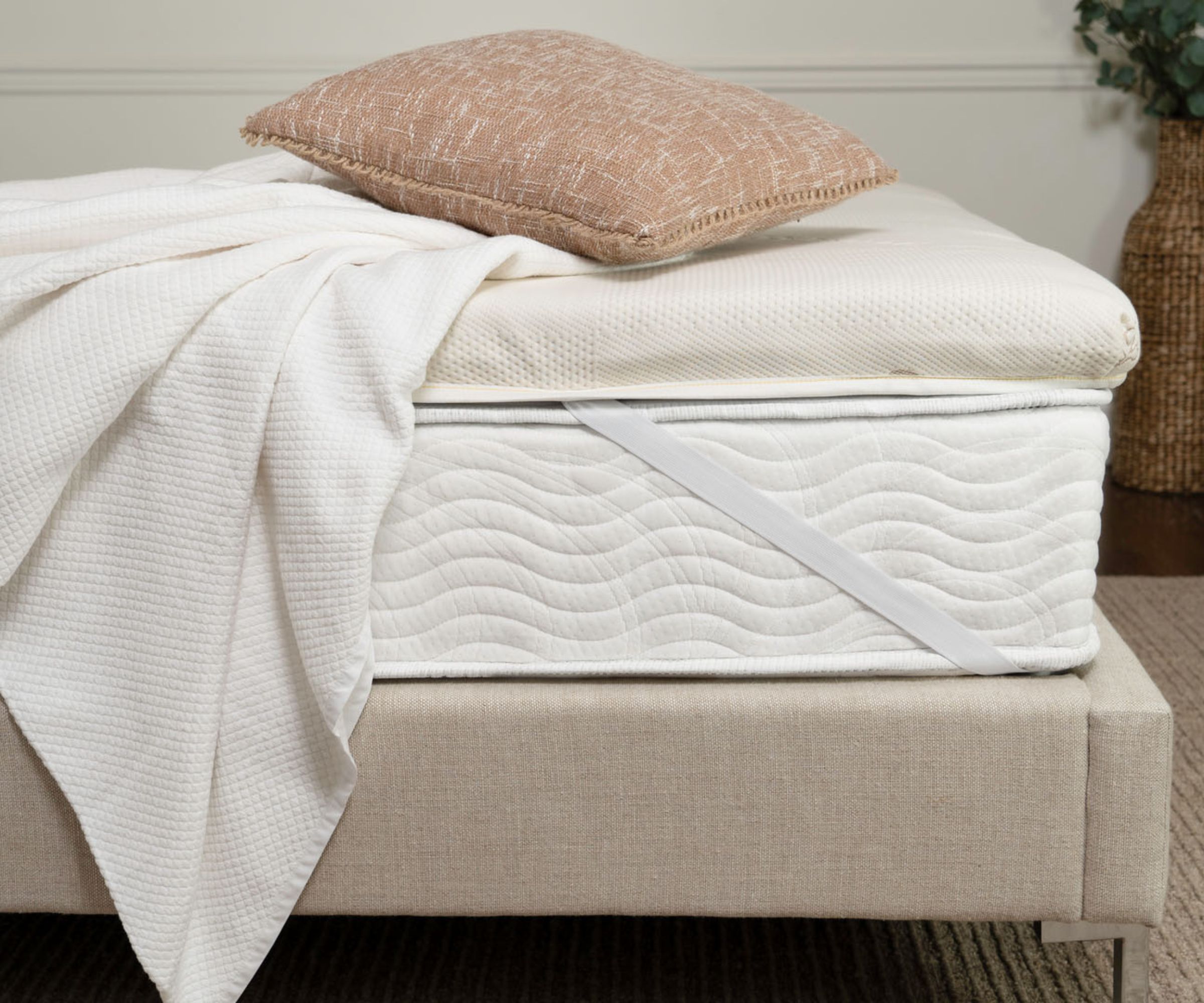How to choose a mattress topper – 6 things you need to know before you buy
I'm a professional product tester – here's how to choose a mattress topper that supports your spine, keeps you cool, and stays on the bed


The right mattress topper could transform the look and feel of your mattress, keeping you cool and comfortable for a fraction of the price of a brand-new bed. I bought my mattress topper when I first went to college. I was sick of waking up stiff and sore from my dorm bed with the indent of an innerspring across my hip. I logged onto Amazon and ordered the best mattress topper I could afford. My topper strikes just the right balance between softness and support and it totally saved my sleep.
The best mattress topper should complement the state of your current mattress. You want a firm, supportive topper for a soft, sagging mattress, for example, and a plush topper for a firm, inflexible mattress. If you're a hot sleeper, you might like a cooling mattress topper. If you tend to move around in your sleep, you want a mattress topper with secure straps to stay on the bed. With so much to think about, it can be hard to choose a mattress topper.
That's where I come in. As H&G's resident sleep writer, I lead a team of expert testers in the search to find the world's best mattress toppers. Together, we've tested a total of 12 toppers, from plush pillow tops to memory foam models. My testing team represents a wide range of ages, body types, and sleep styles, so I know the pros and cons of different mattress topper types for different sleepers. I can teach you how to choose a mattress topper that meets your needs and comes in under budget.
How to choose a mattress topper − 6 things you need to know
Before you can choose a mattress topper, you need to set an upper and lower limit to your budget. As we enter shopping season, the mattress sales are ramping up. I've already seen some deep discounts on mattress toppers. Still, I'd urge you not to sacrifice quality for cost. It's worth slowing down while you shop and following my mattress topper buying rules to avoid buyer's remorse.
1. Understand your sleep style

There are three primary sleep positions: side, back, and stomach. If you tend to flip between two or three of these positions in the night, then you're what's known as a combination sleeper. When you lie in a particular position on the bed, you're putting certain parts of your body under more stress and strain. You need to find a mattress topper in the best mattress firmness to cushion those pressure points while keeping your spine straight.
For side sleepers, I'd recommend a medium firmness mattress topper, filled with memory foam or tufted in a pillow-top. Side sleepers need a mattress topper with enough give that their shoulders, hips, knees, and ankles can sink into the surface, but enough support to stop their spine from falling out of alignment.
For back sleepers, I suggest a medium-firm mattress topper, which lifts the lumbar region but allows the shoulders to sink in. For stomach sleepers, I suggest a firm mattress topper, filled with high-density memory foam or natural latex. You want something that supports your hips to stop your back from arching.

'This firm memory foam mattress topper is just the thing to toughen up a soft, sagging mattress,' says expert tester Jamie Davis Smith. 'For a little less than $300, you get deep support, excellent motion isolation, and pressure relief around your hips, knees, and shoulders.'
Read the full review: Nolah Mattress Topper

This is the most expensive mattress topper we've tested, but it's proof that you get what you pay for. The latex support core is springy and responsive, while the wool and cotton comfort layers work to cushion your joints.
Read the full review: Saatva Organic Quilted Mattress Topper

Filled with springy and supportive Talalay latex, this plush topper would be just the thing to soften up a firm, inflexible mattress. It's a great option for side sleepers and anyone in need of pressure relief.
Read the full review: Birch Plush Organic Mattress Topper
2. Get to know your topper types

Now that you've found your ideal topper firmness, it's time to work out which materials best meet your needs. Sometimes, you don't need to sleep on a mattress topper to understand how it feels: you just need to check the specs.
Memory foam is made to absorb motion and contour around your curves to give you the feeling of weightless sleep. It's a good option for couples, light sleepers, and anyone in need of pressure relief. For the best balance of comfort and support, I recommend a high-density memory foam mattress topper. If you're a hot sleeper, be warned that memory foam isn't especially breathable: all that thick foam leaves little room for air to flow. Your best bet to keep cool is a gel memory foam mattress topper.
Latex tends to feel firmer than memory foam, and cooler, too − natural fibers are always more breathable than their synthetic substitutes. I'd recommend a latex mattress topper for back and stomach sleepers, as well as hot sleepers. The biggest downside is the cost: latex is one of the most expensive mattress materials, especially if you want to go organic.
If you sleep on your side, or you suffer from aches and pains and you're crying out for pressure relief, then you'll appreciate the plush comfort of a pillow top or featherbed. These toppers are soft and squishy, but they aren't quite as supportive as a latex or memory foam mattress topper.

This is our reigning champion for the title of 'best mattress topper', with perfect scores across the board for pressure relief, motion isolation, and edge support. When you shop with the code TOPPERS40, you can save more than $150.
Read the full review: Tempur-Pedic Tempur-Adapt Topper

You can customize this mattress topper to meet your sleep needs. The Avocado Organic Latex Mattress Topper comes in six sizes, two heights, and two comfort levels (Medium and Plush) to suit every style of sleeper.
Read the full review: Avocado Organic Latex Mattress Topper

'The plush pillow-top proved just the thing to soften up my old innerspring mattress,' says expert tester Louise Oliphant. 'As a side sleeper, I appreciate the contouring comfort and pressure relief. If you sleep on your back or stomach, then you probably need a firmer surface.'
Read the full review: Coop Retreat Mattress Topper
3. Consider ways to keep cool

If you suffer from night sweats or hot flashes, or you simply tend to run a little warm, then you're what's known as a hot sleeper. One way to stay the right side of cool and dry is to invest in one of the best cooling mattress toppers.
As a general rule, I recommend toppers filled with latex over memory foam for thermoregulation. Latex is arranged in an open-cell structure, which leaves more room for your bed and body to breathe. Still, it's not all about the base layer: pay attention to what makes up the comfort layers inside your mattress. According to the Woolroom Clean Sleep Report 2024, wool is a natural moisture-wicker, able to hold up to a third of its weight (or sweat) to keep your body and bed clean and dry.
With that said, our reigning champion for the title of 'best cooling mattress topper' is filled with memory foam. The secret to the cooling lies in the graphite infusion. Graphite is a highly conductive material, which works to carry excess thermal energy away from your body and out of the bed. You'll see similar results from copper, green tea, and all manner of cooling gels.

'I started testing the Saatva Graphite Mattress Topper in the middle of July in a room without AC,' says expert tester Kaitlin Madden. 'I was surprised to find that I slept comfortably all night long.' Graphite is a natural conductor, carrying excess thermal energy away from the body and out of the bed.
Read the full review: Saatva Graphite Mattress Topper

This memory foam mattress topper is infused with copper to dissipate heat, wick moisture, and block odors. Our expert tester, Lauren Allain, took this mattress topper to her friends' houses and even out on a camping trip and she still managed to sleep comfortably.
Read the full review: ViscoSoft Active Cooling Copper Topper

'Compared to my old memory foam model, the Earthfoam Mattress Topper is a revelation,' writes one of our expert testers, Louise. For natural breathability, it doesn't get better than latex, wool, and cotton.
Read the full review: Earthfoam Mattress Topper
4. Shop with straps in mind

The whole point of a mattress topper is to make a quick and easy upgrade to the look and feel of your mattress. The last thing you want is to have to get out of bed in the night to stop your topper from slipping and sliding over your mattress.
For a safe, secure fit, I recommend a mattress topper with corner straps. Some, like the ViscoSoft Active Cooling Copper Topper, come with adjustable corner straps to fit any depth of mattress. Remember, once you've layered your topper over your mattress, you might need to invest in a deep-pocket fitted sheet to stretch all the way around.
Of course, there are a few exceptions that prove the rule. The Avocado Organic Latex Mattress Topper doesn't have straps, nor a stretchy bed skirt – just an organic cotton canvas underneath the topper to maintain friction with the mattress. Before you buy, it's worth learning how to keep a mattress topper from sliding overnight.
5. Ask your partner

Perhaps you and your partner share a bed, but not a sleep style. You might prefer a firmer mattress, while they appreciate a softer surface: where you sleep hot, they might sleep cold. You might need to compromise to find a mattress topper that meets both of your sleep needs.
Most sleepers would benefit from a medium-firm mattress topper to cushion their joints while keeping their spine in line. You're looking for high-density memory foam or latex for support, wrapped in cotton, wool, or cashmere for softness.
In the most extreme cases of incompatibility, I've heard of couples who order a single Twin or Twin XL mattress topper to layer over one side of their Queen or King mattress. That way, you can create two distinct firmness profiles in the same bed.
6. Make sure you need one

As H&G's resident sleep writer, I'm often asked when to buy a mattress topper. If you're sleeping in a dorm or you're renting an apartment where it just isn't practical to get a new mattress, then you might get a lot of use out of a mattress topper. If your mattress is nearing the end of its life, but you can't yet afford to buy a brand-new bed, then a topper could prolong the life of your mattress for a fraction of the price.
A mattress topper is good for many things − often, though, it's only a short-term solution to a more persistent problem with your mattress. If you're wondering whether to buy a mattress topper vs a new mattress, you're in luck: I've weighed up all the pros and cons of either product. Remember, you can always save when you shop the mattress sales.
So, these are my 6 mattress topper buying rules: shop with your current mattress and your sleep position in mind; find ways to keep cool; get straps for a secure fit; consider your partner and their sleep needs; and make sure you really need one before you buy.
Sign up to the Homes & Gardens newsletter
Design expertise in your inbox – from inspiring decorating ideas and beautiful celebrity homes to practical gardening advice and shopping round-ups.

Emilia is our resident sleep writer. She spends her days tracking down the lowest prices on the best mattresses and bedding and spends her nights testing them out from the comfort of her own home. Emilia leads a team of testers across America to find the best mattress for every sleep style, body type, and budget.
Emilia's quest to learn how to sleep better takes her all around the world, from the 3Z mattress factory in Glendale, Arizona to the Hästens headquarters in Köping, Sweden. She's interviewed luxury bedding designers at Shleep and Pure Parima, as well as the Design Manager at IKEA. Before she joined Homes & Gardens, Emilia studied English at the University of Oxford.
-
 How to clean a patio – 6 different methods, and when you must use a chemical cleaning agent
How to clean a patio – 6 different methods, and when you must use a chemical cleaning agentFrom manual scrubbing, natural solutions or calling in the pros, industry experts reveal the benefits and considerations of each method
By Andy van Terheyden Published
-
 Kris Jenner's favorite air fryer, the Ninja Crispi, is the perfect small kitchen solution – it deserves a place on the most compact of countertops
Kris Jenner's favorite air fryer, the Ninja Crispi, is the perfect small kitchen solution – it deserves a place on the most compact of countertopsKris approves of this compact yet powerful air fryer, and so do our own kitchen appliance experts, praising it for its multifunctionality
By Hannah Ziegler Published